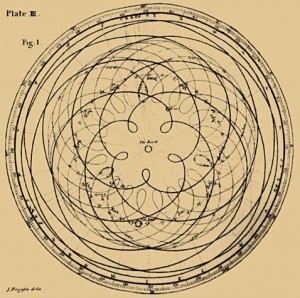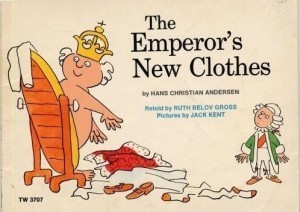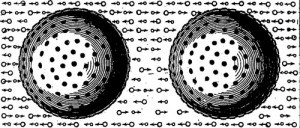Next month a total solar eclipse will be seen across the United States. It is one of the few eclipses to trace a path through several densely populated areas, and that means there’s plenty of opportunity to do some experiments, including one that’s stirred a bit of controversy for the past 60 years.
The most famous eclipse experiment is Arthur Eddington’s 1919 experiment showing that starlight is deflected by the mass of the Sun. It was the first experiment to confirm that Einstein’s theory of relativity was correct. But perhaps the second most famous eclipse experiment was performed in 1954 by Maurice Allais. Allais was an economist, and won the Nobel Prize in Economics in 1988. But he was also interested in alternative theories of gravity and electromagnetism. He thought that gravity could be an effect of a cosmic aether, and that effects of this aether could be observed during a solar eclipse. So in 1954 Allais conducted a simple experiment with a Foucault pendulum.
A basic pendulum is simply a mass connected to a cable or rod. When the pendulum is released, it swings back and forth at a regular rate. But given a bit of time time, the orientation of a pendulum will shift. The direction of its back and forth motion will change. This was first noticed by Léon Foucault in the 1850s. As Foucault demonstrated, the gradual shift of a pendulum is due to Earth’s rotation. Everything on the Earth moves around in a circle once a day. If you are on the equator, you would travel the entire circumference of the Earth in 24 hours. If you are near the north pole, you would travel only a small circle in 24 hours. This means that while everything on Earth moves in a circle once a day, things closer to the equator move faster than things closer to the Earth’s poles. Your speed depends upon your latitude. As a pendulum swings, it will be slightly closer to the equator at one part of its swing, and slightly farther away at another part. As a result, the motion of the Earth causes the orientation of the pendulum to shift slightly with each swing, an effect known as precession. The effect is very small, but it builds up.
Because the precession is due to Earth’s rotation, traditional physics says the rate of precession should be the same during an eclipse as any other time. But when Allais did his experiment, he found the rate of precession shifted during the eclipse. This came to be known as the Allais anomaly, or Allais effect (not to be confused with the Allais paradox, which deals with his economics work). This was unexpected, and it generated a lot of criticism. One of the main arguments was that Allais was not an experimental scientist. Although the experiment seems simple, it could be influenced by things such as atmospheric changes of temperature, pressure and humidity which can occur during a total eclipse. Eliminating these factors is challenging, even for an experienced experimentalist. A second criticism was that there is no clear mechanism for such an anomaly. Even Allais didn’t have a claim a mechanism beyond some vague non-traditional effect.
Of course the real proof of the pudding would be to repeat the experiment. Either the effect is real or it isn’t, and further experiments should lead to the truth. But total solar eclipses are not overly common, and they don’t often occur over university research labs. So only a handful of experiments have been done, and they’ve been done with equipment of widely varying precision. The results have been mixed. Allais repeated the effect in 1959, and found the effect again. In 1965 an experiment using a more precise gravimeter device found no effect, while a pendulum experiment in 1970 found some effect, though the cause was unclear. One of the more precise pendulum experiments was performed in 1990 by Tom Kuusela. Kuusela found no effect to within 1 part in 4 million. Another one by Horacio R. Salva in 2010 also failed to see any effect. So it seems pretty clear that the effect isn’t real. But that hasn’t stopped the controversy. There are a few experiments that claim to observe the effect, though they tend to be published in less mainstream journals. Supporters of the effect have cited it as evidence for everything from dark matter to the electric universe and a flat Earth. If you delve deep enough you find accusations that NASA covered up research from several eclipse experiments.
Long story short, the Allais’ effect was likely due to experimental error, but it remains an interesting story.
Paper: Maurice Allais. Should the Laws of Gravitation be Reconsidered?, Aero/Space Engineering 9, 46–55 (1959)
Paper: Kuusela T. Effect of the solar eclipse on the period of a torsion pendulum, Phys. Rev. D 43, 2041–2043 (1991)
Paper: Horacio R. Salva. Searching the Allais effect during the total sun eclipse of 11 July 2010. Phys. Rev. D 83, 067302 (2011)













Comments
In a way, this story echoes that of cold fusion. If the effect were as real and pronounced as the original claim, well, then we’d have to elevate it to the level of the gravity experiment performed by Henry Cavendish.
Unless you want to violate causality, story of cold fusion echoes Allais’ story, not the other way round 🙂